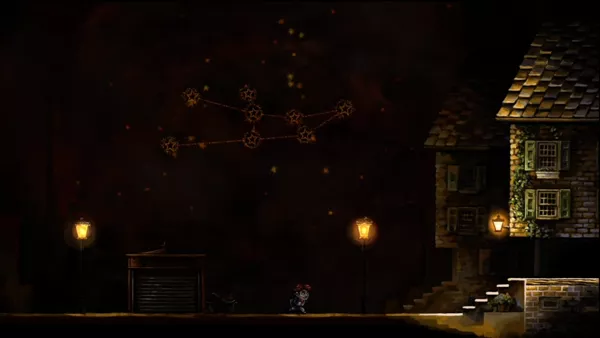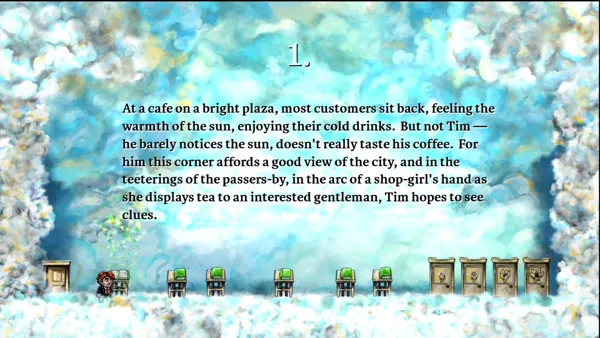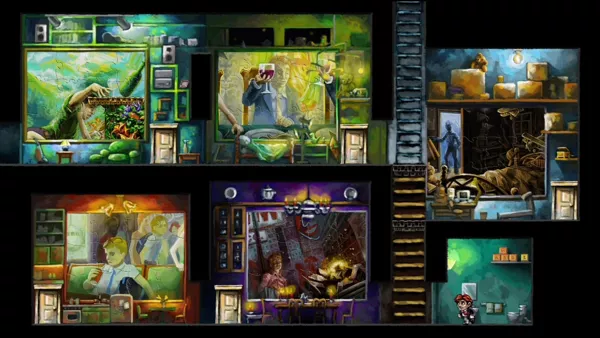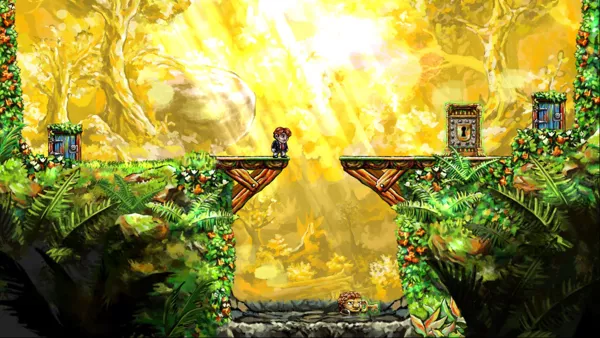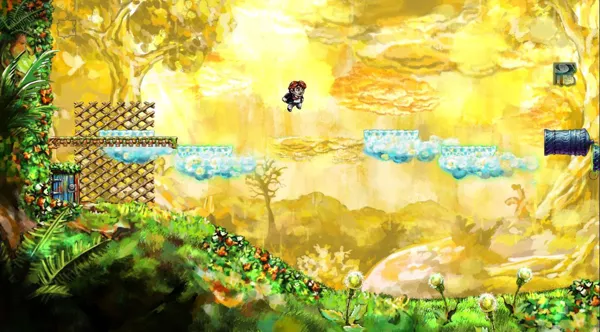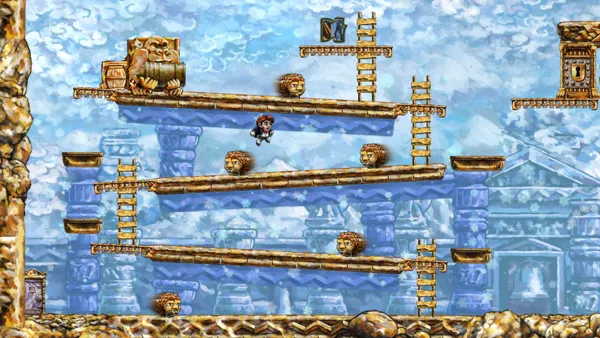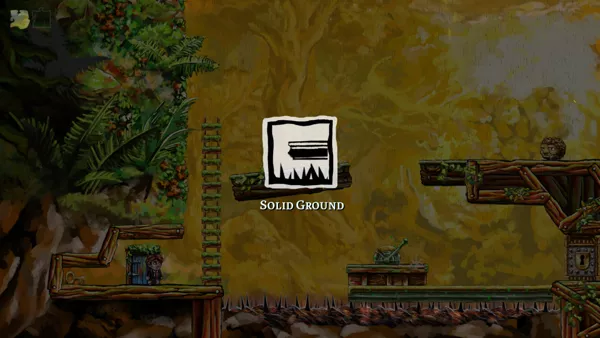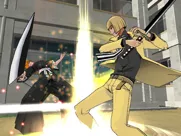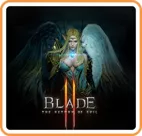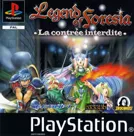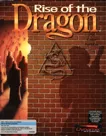Braid
Description official descriptions
Braid is a puzzle game disguised as a 2D platformer. The player controls Tim during his search for a princess he has known and lost. Although the objective appears to be rather straightforward at first, the meaning and the motives become much more implicit and are interwoven with the mechanics during the course of the game. From the main hub, Tim can eventually access six worlds that consist of different areas. The start of each world reveals a part of Tim's background and emotions, rather than progressing a storyline. The second to the sixth world can be entirely explored without solving all the puzzles. Difficult situations can be ignored and revisited later. When all worlds have been completed, the first one becomes available and brings closure to the story.
The game's concept is entirely based on time manipulation. Tim cannot die permanently as the player can rewind time at any moment and usually for any length, even all the way back when an area was entered. While rewinding, the music is synchronized in a similar fashion. Rather than a gimmick, rewinding is an essential element to solve the puzzles. The different worlds give a spin to the mechanic by introducing clones as the player collaborates in a parallel reality with a past version of himself, time can be affected through the movement direction, and Tim can create a circular area to cause time dilation. Certain items, enemies, and parts of the scenery are immune to time manipulation or behave in a very different way. Puzzles require close examination of the environment and the behavior of different items and enemies. As such, the game is entirely about solving the puzzle theoretically by applying the game mechanics and then using trial and error to executive it and discover possible flaws in the proposed logic. This also brings limited replayability to the game.
A world is solved by collecting the puzzle pieces. These need to be arranged and eventually show a picture related to the game's story. There is no filler in the level design, meaning that every platform, item, or game element (except for a few enemies) has a specific purpose to solve a puzzle. Fast times can be tracked in a separate speedrun mode.
The later released Windows and Macintosh versions are identical but come with a level editor.
Spellings
- ブレイド - Japanese spelling
Groups +
Screenshots
Promos
Videos
Add Trailer or Gameplay Video +1 point
See any errors or missing info for this game?
You can submit a correction, contribute trivia, add to a game group, add a related site or alternate title.
Credits (Xbox 360 version)
86 People (77 developers, 9 thanks) · View all
| A Game by | |
| Graphic Art by | |
| Additional Graphical Effects Programming by | |
| Animation Prototyping by | |
| Additional Sound Effects by | |
| Helpful Patron | |
| XBLA Facilitation | |
| Room and Board | |
| Rewind Evangelist | |
| Play-Testing and Discussion | |
| Special Thanks | |
| [ full credits ] | |
Reviews
Critics
Average score: 92% (based on 75 ratings)
Players
Average score: 4.0 out of 5 (based on 140 ratings with 7 reviews)
Poor puzzles, poor story and poor references, but hey, it's artsy so we have to like it.
The Good
The backgrounds in this game are very beautiful, every single one of them is hand-drawn and the aesthetic is very original. Braid focuses mostly on looking beautiful and I'll be damned if it doesn't pull that off very well. The art-style for the backgrounds also fits really well with the level-design and the style is consistently present, while also varying enough to stay interesting.
Likewise, the spriting is also done very excellently. I want you to jump on one of the basic enemies and then slowly reverse time, you will see the expression on the sprite change slowly instead of an instant-transition, that's pretty cool. Like with the backgrounds, the sprites fit really well with the overall aesthetic and this all creates a sense of atmosphere that I personally found quite endearing.
Like with "Banjo & Tooie" this game has you assembling puzzles, this time around in order to finish a level off entirely. I actually really enjoy this, I like making puzzles and when done virtually I don't end up with a million boxes and missing pieces.
The Bad
The story in this game is very poorly implemented, to the point of it been a few steps back in video game storytelling. Remember how I said that in "Bastion" the gameplay and story are perfectly put together? Braid does the complete opposite and gameplay and story are kept miles away from each other. Before you start each level there are a few books on pedestals that you can read, each containing an entire paragraph of ambiguous text that is supposed to form the story. Some call this poetry, but I call it retarded. I am not saying that a 2D platformer can't have a story, but when we have to go out of our way to read a load of text before we get to play, then that is clearly a failure. As for the content: I am underwhelmed. Every level just turns around the same thing: Tim is a whiny idiot, he is looking for a princess and the game can't go for a single level without referencing the atomic bomb.
On the gameplay side of things there is nothing groundbreaking to be found either, in fact, the gameplay feels very out of place. The story and atmosphere set the game up as a very dark or at least a dramatic experience, but once gameplay starts you are jumping around with cute creatures while cheerful music plays in the background. At first glance the first level appears to be doing a Mario reference, but you quickly realize that the entire game is a Mario reference. Every single level uses the piranha plants coming out of green pipes, goomba-like enemies walking straightforward until they hit something and weird-looking creatures at the end of levels telling you the princess is somewhere else. The entire game is like this, so I consider myself justified in saying that it's just Super Mario with puzzles and artsy bullcrap thrown into the mix.
Unlike what the creators claim, the puzzles in this game border on the horrendous. Their official strategy guide says that all the puzzles are fair and never involve guessing, but in the very first level I was confronted with a puzzle that demanded that I grew bored and started fucking around with the scenery (turned out you could move the picture frame, thanks for hinting at that, that clearly didn't leave me guessing for random solutions). There are plenty of examples all around and one of the most mind-bending of them is a puzzle where there are two doors and only one key, one door opens and the other breaks the key and forces you to repeat the entire stage. That is a returning puzzle, ladies and gentlemen!
In fact, there are quite a lot of stages that demand you reset everything if you make even one mistake. One annoying example was early on in a level where certain elements were immune to your time-reversing abilities. The only puzzle here was that two platforms were moving towards each other at exactly the right timing, but one was immune and the other wasn't, so in order to prevent a conflict I just had to wait... next to three enemies with varying attack patterns.
Also unfair about the puzzles is that they are incredibly overwhelming. Many stages contain various dynamic objects that start working the second you enter, this creates the problem that the player can never get his bearings before diving into the actual puzzle. Imagine if you're playing Banjo & Kazooie and once you enter Mumbo's mountain you don't start off on top of that hill without enemies, but next to that monkey throwing fruit at you and with no way to escape. As the game is normally, you can observe the monkey from a distance, but in this scenario (which is what Braid does) you are just going to run around in circles because you can't grasp what is happening around you. What Braid does can be done right, like in Ocarina of Time where you enter that icy room with the timer, it gives you a quick adrenaline-kick and forces you to think faster than usual, but when the entire game is like that...
The Bottom Line
Many people praise Braid because it shows that "games are mature" and "games are art", but personally I can only see a poorly-assembled mess of a game. I do believe that some games are mature and I most certainly believe that games art, however I also believe that you don't need to throw in pointless references or ambiguous paragraphs of text to achieve it. I think Bastion is a piece of art, the same can be said about The Path, "art" is not some kind of official stamp that government employees hold meetings over, it's an opinion that varies from person to person. I think Psychonauts is a piece of art, but on the other side I don't care for modern paintings.
If you hang out on websites like The Escapist were any game that a reviewer calls art is immediately consider to be 100% flawless, then this title should definitely be on your to-play list. Besides that, I can only recommend this game to the so-called "hipsters".
Windows · by Asinine (957) · 2012
The Good
Cool characters. Tim is a short guy that looks mature and wears suits and a tie. The way he looks is symbolic of an old soul trapped in a young/infantile body. It is itself a paradox of time. The main characters, however, are a bunch of lions that Tim jumps on in order to gain access to higher ground. The basic obstacles are similar to Metroidvania games. You can only jump so high, so figure out a way to jump higher. You can't crawl through narrow passages, and you can't morph into a ball. The lions can get there and get the items for you.
Visually fascinating. While the gameplay itself is almost zero fun, I kept playing due to the beautiful graphics, and the following reason.
Deep thoughts and sophisticated views about life, the universe, and existence. I'm touched by World 3 and World 5 especially. In World 5 you create a parallel universe version of yourself, and work with that alter-ego to accomplish a goal together. It makes you ponder upon the choices you have made in life, and how things may have turned out differently. In World 3 a type of glowing objects is introduced that isn't affected by time. It's a symbol of eternity, The Constant, the things in life that never change no matter what happens, such as family, such as There Is A Light That Never Goes Out.
You can't die. It's a game with an undo button that can undo everything you have done. Obviously inspired by the game/software development process itself, as you can type something, change a line of code and then undo. This is a very, very cool and useful feature, that would have been very helpful in a lot of other games.
The Bad
However, Braid doesn't feel any more user-friendly with this unlimited undo feature. You can't die. But you can't solve the puzzle either. About 20% of the puzzles can be solved by a normal person. About 20% more can be solved if you think really hard. The rest of the puzzles are too difficult. Braid really could have been 500% better, if it had just included a hint system. Give me three hints to each puzzle piece. I have to do things to earn the hints. That'll make the gameplay fun. But right now, it's not fun at all, and you constantly have to read a guide just to complete the level.
After reading the guides, it seems that each puzzle has only one, unique solution. How can a game that covers a topic so broad and deep, be so narrow-minded at the same time?
How about this: Let's summon Tim right now and rewind back to the day Braid was released, and surround Jonathan Blow, the project manager, with a bunch of lions and rabbits that are immune to everything ever. The lions and rabbits will not go away until Jonathan Blow give us three hints to each puzzle.
The Bottom Line
Unless you have the ability to manipulate time, and then manipulate Johnathan Blow, there really isn't any fun in Braid. It's probably not meant for that either. A game that aims to provide not fun, but deep questions, and eternal answers.
Windows · by Pagen HD (146) · 2013
The Good
When it was released, Braid surprised the whole videogame world because of its combination of platforms and puzzle genres. We must be clear about that, Braid's not a platform game with some concrete puzzles in some certain places, Braid's just the opposite, a puzzle game with a slight platform feel on its design. Braid's key to congeniality is the concept, unique and new in everything like gameplay, storyline or main design. Braid's programming is incredible, playing with the time as no other game has never done.
Time's the main incentive for this game as well as the main headache for the players. The game is divided in different worlds (well... rooms of the main character's house), and each world has a different use of that feature, like going back as if you were Prince of Persia's main character using the sands of time, or using a strange ring that allows you to slow what's near of it. Each world's different, so, what you've done in previous world will not work in the others.
Braid's gameplay is simple, and you'll use (most of the time) just the jump button, and another one to press switches. You have another button to go back in time if you've done something wrong, which means that you're immortal because you can use it all the times that you want or need it. Anyway, you'll realize soon that "loosing a life" is not the worst thing that could happen here (to start with, there are no lives), you won't even hate your enemies, because the main problem are puzzles. Some of them are as complicated as annoying is the main storyline.
Puzzles are perfect, yes, and the best thing on it is the fact that when you play and face one of the puzzles, you'll think that you'll need a skill (like double jumping or something) taken in the future and then come back to where the puzzle is to solve it. Yes, you're right, you can turn back anytime you want to solve those puzzles that you couldn't solve, but there are no skills along the game, what means that you can complete all the puzzles from the start.
Besides breaking player's brain, Braid is a game with good taste, and it pays tribute to many important games such as Super Mario, Donkey Kong or Ghosts 'N Goblins along the adventure. Graphics aren't the best graphics ever seen, but they're unusual beautiful. This feeling is in the whole game, in every art of it, a nice mix including a melancholic story, green stages with many beautiful details and suitable music with clear Celtic influences.
The Bad
Story's a complete nonsense, complicated and annoying. Even the designer admitted it, something abstract without a meaning. When you finish it there are so many different interpretations for what you've played that you'll start looking for an answer and you'll find out that no official explanation exists, only a few clues but nothing concrete. What you see in the game is beautiful until you reach the ending part. Of course, to like or not the ending is something subjective, but that strange story (which is clearly the biggest headache for the player, much more than the puzzles out there) is so annoying that many players will be disappointed once they've spent a lot of time solving those hard puzzles.
Game's length is a big problem because it's really short. Some puzzles need many time to be solved, but some of them don't. Just a pair of them will need many hours, and we must add that we've lost, partly, that spirit of the old school gamer that would never use a game guide, so, it's probably that if you don't know how to solve a puzzle you'll look for extra help, and that makes the game really short (moral: don't use any guide or external help!).
When most of the puzzles are solved, the credit goes to the player. You won't solve puzzles by chance and it won't even help you a bit, but there's a concrete world in which that could happen because of its confusing way of using the time feature. Well, maybe you won't solve puzzles that way, just by chance, but it's possible that you solve some of them repeating different things until you find the correct one, without knowing exactly what you had to do to solve it.
Forget about taking all the secret stars on the game. We're talking about one of those games where secrets are impossible to find by your own way. You won't even know it by intuition, so, forget it or look directly for a game guide.
The Bottom Line
If your looking for a platform game avoid Braid. If what you want is a game with many different puzzles to get a headache or to be proud of yourself once you've solved them, Braid's your game. The design of the game is beautiful, so beautiful that you'll be attracted to it immediately, but what's inside of the game is what makes this game shine with its own light. Besides its short length and the annoying story, one of the most important independent games released.
Windows · by NeoJ (398) · 2010
Discussion
| Subject | By | Date |
|---|---|---|
| Recommended literature | Sciere (930486) | Sep 7, 2008 |
Trivia
1001 Video Games
Braid appears in the book 1001 Video Games You Must Play Before You Die by General Editor Tony Mott.
Budget
Developer Jonathan Blow said he invested about $180,000 of his own money in a three year period to create the game.
Inspiration
In an interview with the website Joystiq on 25th September 2008 Jonathan Blow cites the musical influences that initially lived in the same emotional neighborhood as Braid: the album Horse Stories by Dirty Three, the music of Lisa Gerrard, and the soundtrack to Dead Man by Neil Young.
References
Many of Braid's levels appear to draw their names from various cultural sources: level 3.2 -- There and Back Again -- is from fictitious hobbit Bilbo Baggins' autobiographical account of his adventures in author J.R.R. Tolkien's The Hobbit, while level 3.4 -- The Ground Beneath Her Feet -- is named either after a book of the same name by author Salman Rushdie or the U2 song also inspired by the book. Level 3.6 -- Irreversible -- suspiciously shares a title with a French film told employing an unorthodox time flow, while levels 4.2 -- Jumpman -- and 6.6 -- Elevator Action -- are names of video games. (Level 6.7 -- In Another Castle -- is one of many nods this game plays to the great granddaddy of the platform genre, Super Mario Bros.)
Awards
- GameShark
- 2009 - Best Xbox Live Arcade Game
- GameSpy
- 2008 – XBLA Game of the Year
- IGN
- 2009 - Overall Best Puzzle Game
- 2009 - Best PS3 Puzzle Game
- 2009 - Best PC Puzzle Game
Information also contributed by Big John WV and Sciere
Analytics
Upgrade to MobyPro to view research rankings!
Related Sites +
-
Braid
Official game website -
Braid
TIGdb entry. -
Mac Gamer Review
A review of Braid by the Mac Gamer's Brad Snios, who had a generally favorable outlook on the game and its nature as a port (July 17th, 2009). -
Podtoid 66: Braidtoid
A podcast with Jonathan Blow about the game design, hosted on Destructoid (21st August 2008) -
The Art Of Braid: Creating A Visual Identity For An Unusual Game
Artist David Hellman explains his collaboration with Jonathan Blow to create the art for the game, on Gamasutra (5th August 2008) -
The aesthetics of puzzle game design — A good puzzle game is hard to build
Interview on puzzle game design to Jonathan Blow, author of Braid, along with Sokobond's Alan Hazelden, and Jonathan Whiting, co-author of Traal. -
Wikipedia: Braid
article in the open encyclopedia about the game -
X360A achievement guide
X360A's achievement guide for Braid.
Identifiers +
Contribute
Are you familiar with this game? Help document and preserve this entry in video game history! If your contribution is approved, you will earn points and be credited as a contributor.
Contributors to this Entry
Game added by Sciere.
PlayStation 3 added by Kaminari. OnLive added by firefang9212. Linux added by Iggi. Xbox One added by MAT.
Additional contributors: Kabushi, Pseudo_Intellectual, Solid Flamingo, Zeppin, Patrick Bregger, Starbuck the Third, FatherJack, Kennyannydenny, click here to win an iPhone9SSSS.
Game added August 8, 2008. Last modified March 31, 2024.



